St Buryan
| St Buryan | |
| Cornwall | |
|---|---|
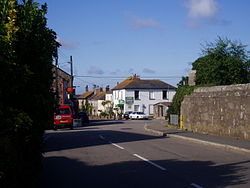 St Buryan | |
| Location | |
| Grid reference: | SW409257 |
| Location: | 50°4’30"N, 5°37’16"W |
| Data | |
| Population: | 1,377 (2011) |
| Post town: | Penzance |
| Postcode: | TR19 |
| Dialling code: | 01736 |
| Local Government | |
| Council: | Cornwall |
| Parliamentary constituency: |
St Ives |
St Buryan is a village in far western Cornwall, about five miles west of Penzance (along the B3283 towards Land's End).
The village of St Buryan itself is also a site of special historic interest, and contains many listed buildings including the famous grade I listed Church.
The wider Parish of St Buryan encompasses the villages of St Buryan, Lamorna, and Crows-an-wra, Sparnon and Tregarnoe, and shares boundaries with the parishes of Sancreed and St Just to the north, Sennen and St Levan (with which it has close ties) to the west, with Paul to the east and by the sea in the south. All this lies in an area of outstanding natural beauty with many 'sites of special scientific interest' in the surrounding area.
The parish is dotted with evidence of Neolithic activity, including stone circles and Celtic crosses, burial chambers and ancient holy wells.
Many painters of the Newlyn School including Samuel John "Lamorna" Birch were based at Lamorna in the south of the parish. St Buryan Village Hall was also the former location of Pipers Folk Club, created in the late 1960s by celebrated Cornish singer Brenda Wootton.Today St Buryan is a prominent local centre housing many important amenities.
Geography
Carn Brea, (50°5’41"N, 5°39’29"W), often described as the first hill in Cornwall, from a westerly perspective, sits at its northernmost edge and rises 657 feet above sea level The hill is also an important historical site showing evidence of neolithic activity, as well as the remains of the chapel from which it is named. The south of the parish slopes down toward the sea in several deep cut river valleys at Lamorna, Penberth and St Loy that are both sheltered and heavily forested.
Name and legend
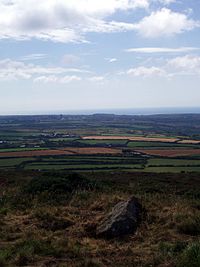
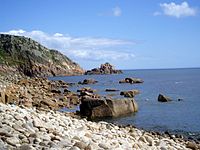
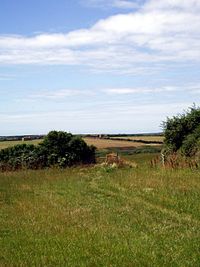
The village is named after the 6th century Irish Christian missionary Saint Buriana (also sometimes called Beriana, Buriena, or Beriena).
The local legend describes how, whilst ministering to the local inhabitants from the oratory that stood on the site of the current church, Saint Buriana was abducted by the local king, Geraint (or Gereint) of Dumnonia. Saint Piran, patron saint of Cornwall and also a fellow missionary, negotiated for her release, but the reticent Geraint agreed only on the caveat that he be awoken by a cuckoo calling across the snow, something which would be highly unlikely in mid-winter. The legend states that Saint Piran prayed through the night whilst the snow fell, and in the morning Geraint was awoken by a cuckoo's song. He was so taken aback by the miracle that he honoured his pledge, however, shortly afterwards he changed his mind and tried to recapture Buriana. Buriana is said to have died as Geraint tried to re-imprison her, and was purportedly buried on the site of her chapel.[1]
Historic landscape
St Buryan and the surrounding area is rich in history and has been a centre of human activity for several thousand years.
Neolithic landscape
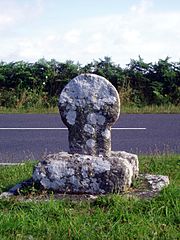
Mant Neolithic sites are found around St Buryan. A mile north of the village is Boscawen-Un, a neolithic stone circle containing 19 stones around a leaning central pillar.[2] The circle is also associated with two nearby standing stones or menhirs. A more accessible stone circle is The Merry Maidens, 2 miles south of the village in a field along the B3315 toward Land's End. This much larger circle comprises nineteen granite megaliths some as much as 5 feet tall, is approximately 78.7 feet (24.0 m) in diameter and is thought to be complete. Stones are regularly spaced around the circle with a gap or entrance at its eastern edge. The Merry Maidens are also called Dawn's Men, which is likely to be a corruption of the Cornish Dans Maen, or Stone Dance. The local myth about the creation of the stones suggests that nineteen maidens were turned into stone as punishment for dancing on a Sunday. The pipers' two megaliths some distance north-east of the circle are said to be the petrified remains of the musicians who played for the dancers.[3]
Many other lone standing stones from the neolithic period can be seen around the parish, at sites including Pridden, Trelew, Chyangwens and Trevorgans.
Bronze and Iron Ages
A few hundred yards from the site of the Merry Maidens is a Bronze Age burial chamber named Cruk Tregyffian, that was discovered (and unfortunately damaged) during widening of the adjacent B3315 road. The circular barrow is composed of stone uprights decorated with cupmarks, dry stone walling and four capstones.[4] The original decorated stone has been removed to Truro museum to protect it against weathering, but a replica now sits in its place.
Further east along the B3315 road, and only a mile from Lamorna, lies the Boleigh Fogou, considered to be one of the best remaining monuments of its kind in Cornwall.[5] The fogou at Boleigh is extensive and has a large entranceway that leads to a long passage with classic dry stone wall and lintel construction. A low doorway just inside the entrance leads to a much narrower and lower passage that turns ninety degrees left after a few yards. After the turn the passage continues for a yard or two before ending; there is a modern metal support grille set into the roof above this section.[5]
Middle Ages
Local traditional claims that in 931 the Cornish allied with the Danes against the English, and King Athelstan defeated the rebellion southeast of Boleigh, where a farm and hamlet now stands. Historians doubt this: the only record of such a war is a story told centuries after the event by William of Malmesbury, who may have confused it with the Cornish-Viking alliance of 835 against King Egbert. A local story tells of ancient armour being ploughed up in the nearby fields at Gul Reeve (a corruption of the Cornish Gwel Ruth, meaning red field).[6]
King Athelstan established a church and monastery in the village, granting it a charter to create a collegiate church and one of Cornwall’s earliest monasteries, which in later centuries made this village an important centre. It is believed that King Athelstan established the church on the site of the 6th century oratory of Saint Buriana.
After the Norman conquest the area fell under the control of Robert, Count of Mortain, a half-brother of William the Conqueror, and St Buryan is mentioned in the Domesday Book with an old Cornish name rendered Eglosberrie and Eglosburrie, meaning 'Church of Buryan':
EGLOSBERRIE; it was free in the time of King Edward; 1 hide. Land for 8 ploughs; ½ plough there. 6 villagers and 6 smallholders. Pasture, 20 acres. Value 10s; when the Count (of Mortain) received the land, value 40s. Also 12 cattle and 12 sheep.[7]
St Buryan was visited by King John in the early 13th century who, after landing at Sennen from Ireland, travelled to the parish to stay the night. By the 14th century St Buryan's importance as a regional centre had grown sufficiently that in 1302 King Edward granted it a weekly market, to be held on Saturdays, and two yearly fairs of three days each to be held on the feasts of St Buryan and St Martin.[6]
As a result of the nature of King Athelstan’s charter, the parish of St Buryan was long regarded as a Royal Peculiar falling directly under the jurisdiction of the King not the Bishop, and this led to several hundred years of arguments between the Crown and the Bishop of Exeter over control of the parish. The dispute came to a head in 1327 when blood was shed in the churchyard. In 1328, St Buryan was excommunicated by the Bishop. St Buryan was not reinstated until 1336.[8]
After the Reformation, St Buryan's importance faded.
Industrial revolution
While other parishes in Penwith were busy mining communities, St Buryan remained largely agricultural. China clay was mined in the parish for a brief period in the nineteenth century in two pits at Tridinney Common and Bartdinney Downs by the Land's End China Clay Company. Although initially successful, by 1891 they had become economically inviable.
Churches
St Buryan's Church
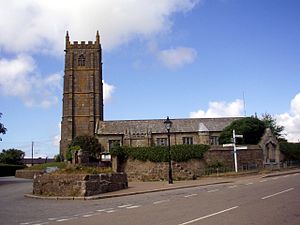
The parish church is the Church of St Buryan; a church has stood on the current site since about 930, when King Athelstan granted its charter, though it is said that the site was earlier that of the oratory of Saint Buriana, probably founded in the 6th century.
Under the terms of the royal charter, the King appointed a Dean to run the church, but in later ages only two of the King's appointed Deans appear to have actually lived in the parish for more than a few months, and this led to the subsequent ruinous state of the church in 1473.
The church was subsequently rebuilt and enlarged, the tower was added in 1501.[9] Further expansion took place in the late 15th and 16th centuries when the bulk of the present church building were added. Further restoration of the interior took place in 1814 and 1956.[1]
The church is currently classified as a Grade I listed building. The Deanery was finally annexed to the Diocese of Exeter in 1663, after the Civil War and Restoration.
St Buryan church is famous for having the heaviest peal of six bells in the world, and a recent campaign to restore the church's bells, which had fallen into disuse, has enabled all six to be rung properly for the first time in decades.[10] The church has four 15th century misericords, two either side of the chancel, each of which shows a plain shield.
Methodism
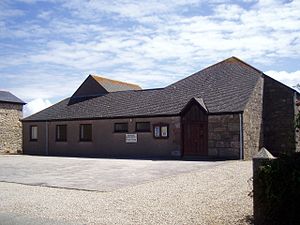
John Wesley, the founding father of Methodism, visited the parish on several occasions, but was not well received at first. He first visited St Buryan in 1747 when he preached at Tredinney, and later attended services at the church in St Buryan during which the local clergyman is reputed to have made several caustic remarks about him.[6] A second visit in 1766, during which he preached from outside the church, led to him being threatened with a whip by the local squire, however this only strengthened his resolve to return.[6][11]
The first Methodist chapel was built in 1783 on a site opposite the present chapel, on land purchased the previous year and inspected by Wesley himself during his last visit to the parish. In 1833, as Methodism became more popular in Cornwall, a second larger chapel was built on the site of the current one. This was subsequently rebuilt in 1981 after suffering storm damage to the old structure.
Further chapels were built in the parish, at Crows-an-Wra in 1831 with seating for 220 as a replacement for an earlier chapel at nearby Treve and at Borah in 1817 with seating for 100, which was rebuilt in 1878. Both of these closed in 1981 as the St Buryan Chapel was enlarged.
A Bible Christian group was also founded in the village in about 1815. With growing support a proper chapel was built in 1860 on the site of the current Hosken's Meadow. This was closed in 1932 but left derelict for another 65 years before being demolished.
Culture
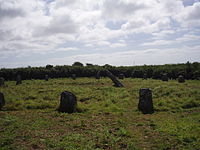
The first Cornish Gorsedd (Gorseth Kernow) in over one thousand years was held in the parish in the stone circle at Boscawen-Un on 21 September 1928. The procession, guided by bards and with speeches mostly in Cornish was aimed at promoting Cornish culture and literature. The modern Gorsedd has subsequently been held nine times in the parish including on the fiftieth anniversary, both at Boscawen-Un and at The Merry Maidens stone circle.[6] There is also a regular Eisteddfod held in the village.
A mMay festival is held every year on the Sunday nearest to 13 May, consisting of fancy dress and competitions for the children of the village and usually other entertainments later in the evening.
In the summer there are also other festivals, including the agricultural preservation rally in which vintage tractor, farm equipment, rare breed animals and threshing demonstrations are shown as well as some vintage cars and traction engines, held on the last Saturday of July.
Outside links
| ("Wikimedia Commons" has material about St Buryan) |
- St Buryan.com
- Some Account of the St. Burian Rood Screen - Robert J. Preston, 1891
- Plan of St Buryan Church by William Smith, 1859
- Cornwall Record Office Online Catalogue for St Buryan
References
- ↑ 1.0 1.1 Blight, J. T. 1856. Ancient crosses & other antiquities in the west of Cornwall; Simpkin, Marshall, & Co., London and F. T. Vibert, Penzance. Published in facsimile combined with the volume about the east of Cornwall and an introduction by Ian McNeil Cooke Men-an-Tol Studio, Penzance: 2004 ISBN 1-902793-02-1. Quoted at West Penwith Resources.
- ↑ Tom Bullock, 2002. "Boscawen Un." Megalithic Portal
- ↑ Stones of England, n.d. "The Merry Maidens
- ↑ Tregiffian Barrow:" Megalithic Portal
- ↑ 5.0 5.1 Boleigh - Souterrain: Megalithic Portal
- ↑ 6.0 6.1 6.2 6.3 6.4 Jim Hosking, 2002. People Places & Past Events in St Buryan. Penzance: J. M. Hosking ISBN 0-9501296-5-8
- ↑ Thorn, Caroline & Frank [eds.], 1979. Domesday Book: Cornwall. Phillimore, Chichester. ISBN 0-85033-155-2
- ↑ F. C. Hingeston-Randolph, ed. Episcopal Registers: Diocese of Exeter. Vols. 1-4. London: George Bell, 1886-97
- ↑ This Is The Westcountry, n.d. "The Great Bells of St Buryan, Cornwall." Verified 2006-08-24.
- ↑ Imperial Bell Weights: The Worcestershire & Districts Change Ringing Association
- ↑ The Rev Robert Corker was curate in charge in 1747; the "gentleman who objected in 1766 is not known"; according to tradition the hepping stock near the churchyard was the site he used for his address in 1766; a third visit was in 1782 when he preached in the afternoon. Wesley, John, et al.; Pearce, John, ed. (1964) The Wesleys in Cornwall: extracts from the Journals of John and Charles Wesley and John Nelson. Truro: D. Bradford Barton; pp. 103, 103n, 146-47, 164.
